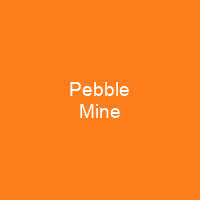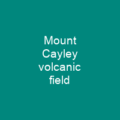Pebble Mine is a very large porphyry copper, gold, and molybdenum mine development project in the Bristol Bay region of Southwest Alaska, near Lake Iliamna and Lake Clark. Pebble holds mostly low-grade ore, requiring a large-scale operation to economically recover it. The ore body extends from the surface to at least 1,700 metres depth.
About Pebble Mine in brief
 Pebble Mine is a very large porphyry copper, gold, and molybdenum mine development project in the Bristol Bay region of Southwest Alaska, near Lake Iliamna and Lake Clark. Pebble is under a broad flat valley at about 1,000 feet above sea level dividing the drainages of Upper Talarik Creek and the Koktuli River. A contiguous body of ore is known as Pebble West where mineralization locally extends to the surface and as Pebble East where it is deeply buried. Pebble holds mostly low-grade ore, requiring a large-scale operation to economically recover it. A 2007 report indicates that magnitude 7. 1 quakes occur on the Lake Clark fault on a 700-year cycle. The subduction zone of the Aleutian Trench lies approximately 125 miles south of Pebble. This zone was the source of the 1964 Good Friday earthquake of magnitude 9. 2. The Augustine Volcano, which lies 25 miles offshore, last erupted in 2006. The Pebble prospect is in a remote, wild, and generally uninhabited part of the Bristolbay watershed. The nearest communities, about 20 miles distant, are the villages of Nondalton, Newhalen, and I Liamna. The site is 200 miles southwest of Anchorage, Alaska. The ore body extends from the surface to at least 1,700 metres depth. In November 2020 the developer was denied a U.S. Army Corps of Engineers permit for its proposed mine discharge plan.
Pebble Mine is a very large porphyry copper, gold, and molybdenum mine development project in the Bristol Bay region of Southwest Alaska, near Lake Iliamna and Lake Clark. Pebble is under a broad flat valley at about 1,000 feet above sea level dividing the drainages of Upper Talarik Creek and the Koktuli River. A contiguous body of ore is known as Pebble West where mineralization locally extends to the surface and as Pebble East where it is deeply buried. Pebble holds mostly low-grade ore, requiring a large-scale operation to economically recover it. A 2007 report indicates that magnitude 7. 1 quakes occur on the Lake Clark fault on a 700-year cycle. The subduction zone of the Aleutian Trench lies approximately 125 miles south of Pebble. This zone was the source of the 1964 Good Friday earthquake of magnitude 9. 2. The Augustine Volcano, which lies 25 miles offshore, last erupted in 2006. The Pebble prospect is in a remote, wild, and generally uninhabited part of the Bristolbay watershed. The nearest communities, about 20 miles distant, are the villages of Nondalton, Newhalen, and I Liamna. The site is 200 miles southwest of Anchorage, Alaska. The ore body extends from the surface to at least 1,700 metres depth. In November 2020 the developer was denied a U.S. Army Corps of Engineers permit for its proposed mine discharge plan.
The mineralization occurs in abundant sills and sediments in the sarther east, east, and deeper, the east and west of the ore body. In the western part of. the orebody, mineralization is in several small granodiorite cupolas, breccias, older intrusions, and sediment sills. The western part. of the deposit is exposed at the surface; thin gossans are developed and developed at 100 and 100 feet in depth. The eastern part of the deposit was eroded at the. surface millions of years ago when it was exposed by a thick-ening by a fault, and has been buried by a depth of millions of feet. It is located 15 miles north of, and upstream of, Lake Iiamna. Water from Lake Clark, approximately 20. miles east of Pebble, flows down the New Halen River to Lake I Liamn. The fault is a major right-lateral strike-slip crustal feature, considered to be a westward expression of the Castle Mountain fault. The actual ground trace of the fault and its splays are unknown in the Pebble area, due to extensive ground cover. A magnitude. 9 quake struck the Denali fault in 2002. This zone is 125 miles north of Pebble and lies about 125 miles south of the Alaskan Augustine Volcano. It last erupted 25 miles off the coast of Alaska in 2006 and is 25 miles from the Pebble prospect.
You want to know more about Pebble Mine?
This page is based on the article Pebble Mine published in Wikipedia (as of Jan. 04, 2021) and was automatically summarized using artificial intelligence.







